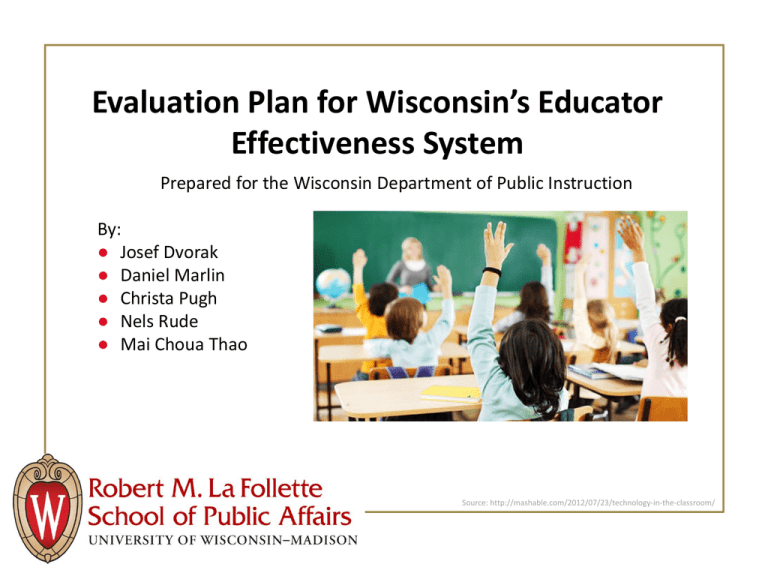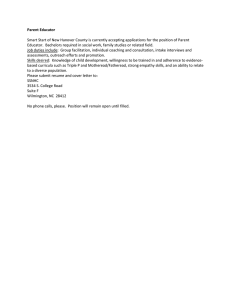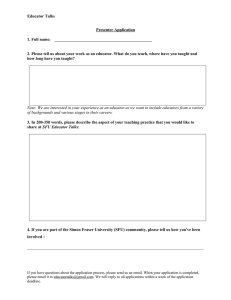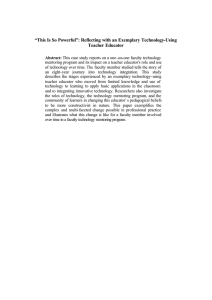Evaluation Plan for Wisconsin’s Educator Effectiveness System
advertisement

Evaluation Plan for Wisconsin’s Educator Effectiveness System Prepared for the Wisconsin Department of Public Instruction By: ● Josef Dvorak ● Daniel Marlin ● Christa Pugh ● Nels Rude ● Mai Choua Thao Source: http://mashable.com/2012/07/23/technology-in-the-classroom/ Background on Educator Evaluation Systems ● Emerging evaluation systems ● Multidimensional evaluation measures ● Value-added modeling (VAM) and other evidence-based metrics ● Professional development ● Summative & formative feedback Source: http://twiniversity.com/2013/12/what-teachers-really-want-for-christmas/ Wisconsin’s Educator Effectiveness System ● Statewide implementation in 2014 ● System goal: “Provide a performance based evaluation that leads to improved student learning by supporting continuous improvement of educator practice.” ● Project goals: ● Identify recommendations for evaluating the Wisconsin Educator Effectiveness (EE) System ● Inform creation of Request for Proposal (RFP) Logic Model Inputs Activities Outputs Outcomes (short-term, intermediate, long-term) Methodology ● State selection criteria ● Contacted all states with a statewide evaluation system ● Found documentation from 15 states ● Highlighted common and novel practices ● Four broad topics of research Recommendations: Research Questions ● Implementation: How was the evaluation system enacted in each site? ● Educator perceptions: What were teachers’ and administrators’ perceptions of teacher evaluation and the classroom observation rubrics being implemented? ● Burdens of reform: What is being done in your school and/or school district to ensure the optimal implementation of the new teacher evaluation system? Source: http://www.c2mclean.com/smarter-students/elementary-school-students/ Recommendations: Research Questions ● Changes to educator behavior: To what extent did participants perceive that initial implementation of the new teacher effectiveness measures resulted in teachers increasingly reflecting about their practice? ● Metric and process fidelity: Do the evaluations produce ratings that are appropriate, valid, and reliable? ● Student outcomes: What is the impact on student outcomes? Recommendations: Metrics ● Implementation ● Perceptions The number of formal classroom observations was adequate to assess my performance. ● Resources I am confident that my district will provide me with the opportunities and resources to achieve system goals. ● Quantitative measures Number of teachers evaluated, median number of observations per teacher ● Educator outcomes Whether teachers changed their educational practices or increased collaboration ● Student outcomes Value-added modeling Source: http://3forward.com/sales-leaders-blog/tips-for-sales-managers-raising-sales-effectiveness/ Recommendations: Data Collection ● Qualitative ● Surveys ● Focus groups ● Interviews ● Quantitative ● Stratified sampling Source: http://www.employeesurveys.com/ Recommendations: Data Analysis ● Aggregate and publish survey, focus group, and interview data ● Statistical methods ● VAM ● Interrupted time-series model Source: http:/Moksony_Ferenc_Statistical_Methods_for_Program_Evaluation/ch07.html /www.tankonyvtar.hu/en/tartalom/tamop425/0010_2A_04_ For further information: Contact the La Follette School’s publications office at 608-263-7657 or publications@lafollette.wisc.edu Or see www.lafollette.wisc.edu/publications/workshops.html Thank you!






